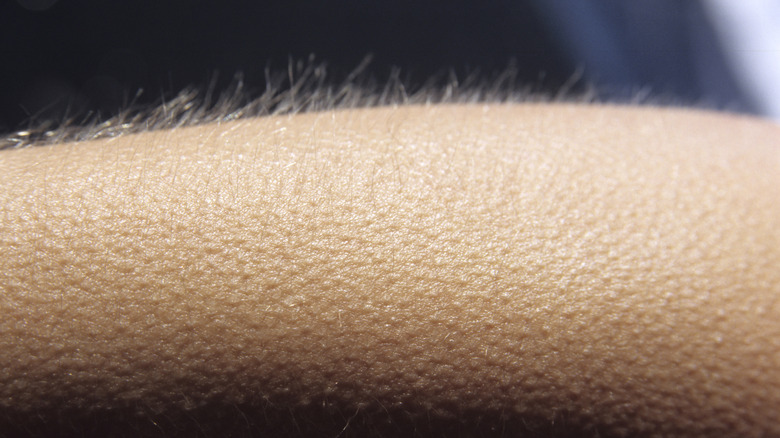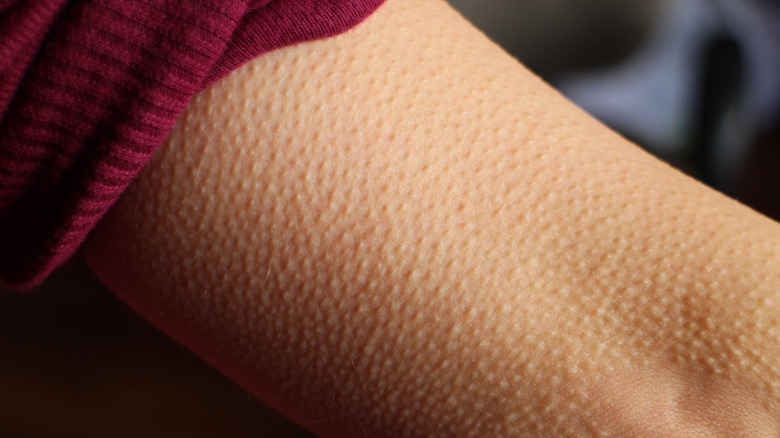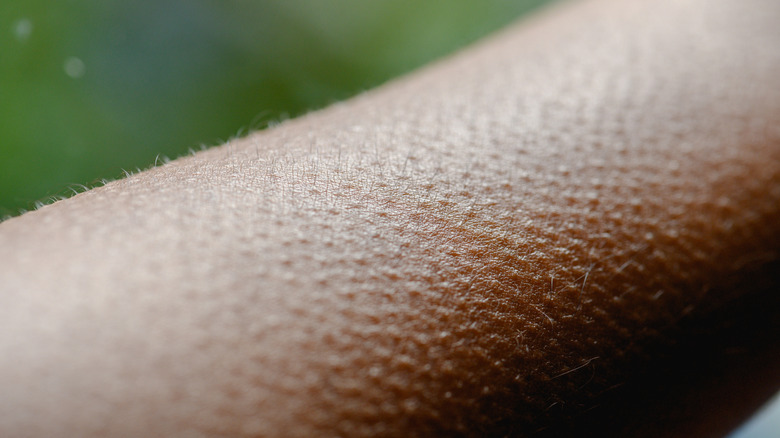The 'Useless' Body Part That Explains Why Humans Get Goosebumps
Along with sweating and ear wax, goosebumps are one of several gross adaptations humans have evolved over the years. Our skin is our largest organ, and does much more than we tend to realize on a day to day basis, regulating our temperature, responding to pain, and even absorbing vitamin D from the sun. But it's even more complex than that, and goosebumps are a perfect example of the diverse array of functions our skin performs.
Otherwise known as cutis anserina ("cutis" for skin and "anser" for goose), goosebumps, and the arrector pili muscles (APM) that control them, appear to be mostly vestigial, which doesn't necessarily mean they serve no purpose at all. Many biologists consider vestigial structures to still provide some function even if they no longer carry out the primary purpose that has been lost as a result of our evolutionary journey. There are many evolutionary functions that the APM and goosebumps once provided, but today they appear to be a remnant of a long lost past. However, new research suggests these muscles might actually play a bigger role than previously thought, bringing into question whether they should be designated as vestigial at all.
Goosebumps used to serve an important purpose
The APM are tiny muscles in our skin which are attached to the base of our hair follicles. Interestingly enough, we don't actually have any APM in the hair follicles of our face, the area just below our shoulders (known as the axilla), nor on our pubis, eyelashes, eyebrows, nostrils, or ear canal. Otherwise, these tiny muscles are attached to hair follicles throughout our skin, and when they contract, the follicles rise and pull the hair upwards in a process known as piloerection. This occurs as an involuntary response to cold or a changing emotional state. The APM is controlled by nerves that control the fight or flight response, and as such we have no conscious control over them, which is why we're often surprised to find that we have goosebumps.
But these tiny muscles and their ability to tug on the hair follicles once performed important evolutionary purposes — the main one being to conserve heat and keep us warm in cold environments. When we as humans were much hairier than we are today, the APM contractions would cause the hair on our bodies to stand up, thereby trapping a layer of warm air beneath. This is thought to have helped us retain body heat. What's more, the contraction of muscles produces heat in and of itself, while raised hair follicles actually cause the skin pores to close, adding a further level of protection against the cold.
It's also possible that raising the hair on our skin may have been a way for us to appear more intimidating when faced with potential predators or attackers. The same way a porcupine can raise its quills when faced with an adversary, humans may have used goosebumps to raise their hair and appear more intimidating, which would explain why the nerves attached to the APM are also connected to our fight or flight response.
Goosebumps might not be as vestigial as we thought
If goosebumps served to keep us warm and potentially as a way to ward of attackers, why do we also get goosebumps when we're excited or experience a sense of awe? Well, that has to do with the fact the arrector pili are attached to the sympathetic nervous system, which as well as reacting to cold and general changes in temperature, is also connected to areas of the brain that control motivation, arousal, and emotion. This is why experiencing something profound or emotionally stimulating can result in us getting goosebumps.
There is thought to be a slightly more gross result of arrector pili contracting, in that it also helps release the contents of the sebaceous glands, which sit between the muscles and the hair follicles. These glands produce an oily substance called sebum, which is important for preventing our skin from drying out. Experts have speculated that when an arrector pili muscle contracts, it squeezes this gland, causing sebum secretion. It's not anything to be particularly concerned about, but a potentially interesting byproduct of APM contraction.
It's also worth noting that the arrector pili muscle is connected to hair follicle stem cells, which play a big role in regenerating the hair follicle. In a 2020 study published in the journal Cell, Harvard researchers working with mice showed that when the APM contracts it also activates hair follicle stem cells, which suggests the sympathetic nervous system actually encourages new hair growth via activation of the APM. This might explain why we have retained the ability to get goosebumps long after the keeping-warm function became unnecessary. In that sense, much like this other "useless" organ that's actually more important than we think, goosebumps may not be quite as vestigial as once thought.


